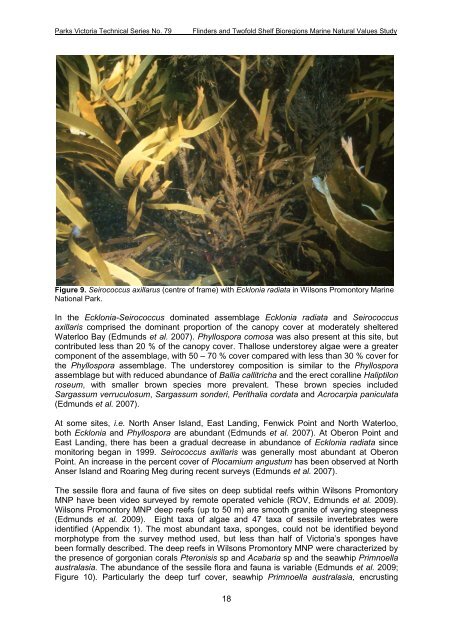parks victoria technical series marine natural values study vol 2 ...
parks victoria technical series marine natural values study vol 2 ...
parks victoria technical series marine natural values study vol 2 ...
Create successful ePaper yourself
Turn your PDF publications into a flip-book with our unique Google optimized e-Paper software.
Parks Victoria Technical Series No. 79<br />
Flinders and Twofold Shelf Bioregions Marine Natural Values Study<br />
Figure 9. Seirococcus axillarus (centre of frame) with Ecklonia radiata in Wilsons Promontory Marine<br />
National Park.<br />
In the Ecklonia-Seirococcus dominated assemblage Ecklonia radiata and Seirococcus<br />
axillaris comprised the dominant proportion of the canopy cover at moderately sheltered<br />
Waterloo Bay (Edmunds et al. 2007). Phyllospora comosa was also present at this site, but<br />
contributed less than 20 % of the canopy cover. Thallose understorey algae were a greater<br />
component of the assemblage, with 50 – 70 % cover compared with less than 30 % cover for<br />
the Phyllospora assemblage. The understorey composition is similar to the Phyllospora<br />
assemblage but with reduced abundance of Ballia callitricha and the erect coralline Haliptilon<br />
roseum, with smaller brown species more prevalent. These brown species included<br />
Sargassum verruculosum, Sargassum sonderi, Perithalia cordata and Acrocarpia paniculata<br />
(Edmunds et al. 2007).<br />
At some sites, i.e. North Anser Island, East Landing, Fenwick Point and North Waterloo,<br />
both Ecklonia and Phyllospora are abundant (Edmunds et al. 2007). At Oberon Point and<br />
East Landing, there has been a gradual decrease in abundance of Ecklonia radiata since<br />
monitoring began in 1999. Seirococcus axillaris was generally most abundant at Oberon<br />
Point. An increase in the percent cover of Plocamium angustum has been observed at North<br />
Anser Island and Roaring Meg during recent surveys (Edmunds et al. 2007).<br />
The sessile flora and fauna of five sites on deep subtidal reefs within Wilsons Promontory<br />
MNP have been video surveyed by remote operated vehicle (ROV, Edmunds et al. 2009).<br />
Wilsons Promontory MNP deep reefs (up to 50 m) are smooth granite of varying steepness<br />
(Edmunds et al. 2009). Eight taxa of algae and 47 taxa of sessile invertebrates were<br />
identified (Appendix 1). The most abundant taxa, sponges, could not be identified beyond<br />
morphotype from the survey method used, but less than half of Victoria’s sponges have<br />
been formally described. The deep reefs in Wilsons Promontory MNP were characterized by<br />
the presence of gorgonian corals Pteronisis sp and Acabaria sp and the seawhip Primnoella<br />
australasia. The abundance of the sessile flora and fauna is variable (Edmunds et al. 2009;<br />
Figure 10). Particularly the deep turf cover, seawhip Primnoella australasia, encrusting<br />
18

















